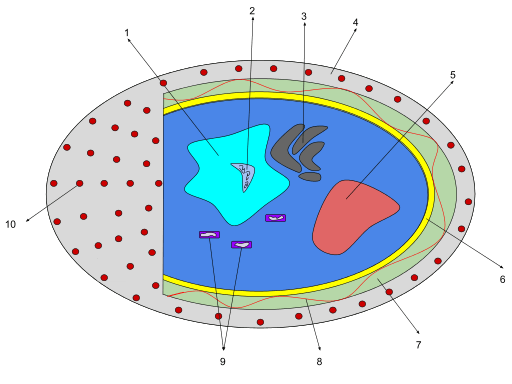
Diatom
n., plural: diatoms
[ˈdaɪ.əˌtɑm]
Definition: a bacillariophyte
Table of Contents
Diatom Definition
A diatom is a unicellular eukaryotic alga characterized by having a siliceous covering and a symmetrical body. Diatoms are mostly aquatic, being found in fresh, brackish, and saltwater. Some are found in moist places, such as soil. Diatoms comprise the taxonomic phylum Bacillariophyta. They may be solitary or in colonies. When in colonies, they form various shapes, e.g. ribbons, zigzags, stars, or fans.
Etymology: The term diatom came from the Ancient Greek diá, meaning “through” andtémnein, meaning “to cut”. Synonyms: bacillariophyte.
Watch this vid about diatoms:
Classification of Diatoms
The phylum Bacillariophyta includes the diatoms. The taxonomic classes of diatoms under Bacillariophyta are as follows:
- Coscinodiscophyceae (centric diatoms)
- Fragilariophyceae (araphids, i.e. pennate diatoms without a raphe)
- Bacillariophyceae (raphids, pennate diatoms with a raphe)
Bacillariophyceae is a taxonomic class comprised of pennate bacillariophytes. It was formerly placed under Phylum Chrysophyta and includes all diatoms. (Ref. 1) Later, van den Hoek et al. 1995 system of classification considered Bacillariophyceae as a class belonging to Phylum Heterokontophyta.
However, more recent taxonomic classification regards this class as a group of pennate or featherlike diatoms and not all kinds of diatoms as what previous systems did and thus, annotate Phylum Bacillariophyta as the phylum of diatoms. (Ref. 2) Ongoing research and studies on these species though may lead to future changes in their taxonomic positions.
General Characteristics

Unicellularity
Diatoms are a major group of microscopic algae and are among the most common types of phytoplankton. Diatoms are unicellular. The cell size may range from 2 to 200 micrometers. (Ref. 3) They may live singly or in colonies.
Frustule
A characteristic feature of diatom cells is that they are encased within a unique cell wall made of silica (i.e. hydrated silicon dioxide). The siliceous cell wall is called a frustule. These walls show a wide diversity in form, some quite beautiful and ornate, but usually consist of two symmetrical sides with a split between them, hence the group name. Diatoms that show radial symmetry are referred to as centric diatoms. Those that show bilateral symmetry are often found among pennate diatoms.
Frustule is formed by depositing silica to the cell wall. Silica is synthesized inside the cell through the polymerization of silicic acid monomers.
Thecae
Diatom cell has two distinct halves: the hypotheca (the slightly smaller theca) and the epitheca (the slightly larger theca). These two thecae often overlap. A girdle called the cingulum connects the two halves of the cell. During cell division, each daughter cell receives one of the two halves and then grows the other half, only smaller. As cell division progresses, succeeding progeny cells tend to become smaller until such time that the progeny cell will no longer divide but form an auxospore that can expand in size.
Pigments
Diatoms have yellowish-brown to olive-brown chloroplasts due to the predominance of chlorophyll (a and c), carotenoids (fucoxanthin), and xanthophylls. Their chloroplasts are four-membraned.
Nutrition
Most diatoms are photosynthetic whereas a few of them are heterotrophs.
Food reserve
Their carbohydrate reserve is chrysolaminarin. They also store lipids.
Lacking flagella
Diatoms do not have flagella except for the male gametes of centric diatoms that have smooth flagella.
Reproduction
Diatoms reproduce asexually by binary fission. The progeny cell that gets to keep the larger theca of the parent cell will have a cell size similar to its parent. Conversely, the other progeny cell that gets the smaller theca of the parent cell will be relatively smaller. Thus, the cell size could decline with the succeeding binary fissions. Sexual reproduction and auxospore formation would help restore the cell size of the diatom population.
Buoyancy
Diatoms are able to stay suspended through various mechanisms. Some of them form spines and form chains to slow their sinking rate Ionic pumps also help to regulate buoyancy. Some produce mucilage to adhere to and glide through a solid substrate, such as on floating debris or on macrophytes.
Ecology
Diatoms are referred to as the jewels of the sea because of their structural coloration. They are major oxygen producers on Earth. They generate about 20% oxygen annually. They are also an important source of silicon through their shell. Some of the diatom species are capable of fixing nitrogen due to the cyanobacterial endosymbiont residing in the diatoms.
Diatomaceous earth or diatomite is a collection of diatom shells in the earth’s crust. It is composed of the fossilized remains of diatoms. It is used in the industry for various purposes. For instance, it is used in water filtration and as a mild abrasive.
Examples
Some of the notable diatoms are as follows:
- Pinnularia is an elongated, elliptical diatom covered in a mucilaginous layer. The genus belongs to the family Pinnulariaceae, order Naviculales, class Bacillariophyceae.
- Navicula is a genus that belongs to the family Naviculaceae, order Naviculales, class Bacillariophyceae. Species of this genus appear like a boat, thus, the name (Latin navicula, meaning “small ship”). It is the genus that produces about a quarter of the earth’s oxygen. Members of this genus also serve as keystone species as they serve as food for many aquatic species.
- Chaetoceros is one of the largest genera of planktonic diatoms in marine waters. It belongs to the family Chaetocerotaceae, class Coscinodiscophyceae.
- Bacillaria is a genus of the family Bacillariaceae, order Bacillariales, class Bacillariophyceae. Members of this genus have elongated cells. They slide past each other to form stacked colonies.
Watch this vids about the diatoms and their important role:
Take the Diatom Biology Quiz!
References
- Bacillariophyceae. Retrieved from ://www.eol.org/pages/3686/overview.
- Pascher, A. (1914). “Über Flagellaten und Algen “. Berichte der deutsche botanischen Gesellschaft 32: 136–160.
- Hasle, G. R., Syvertsen, E. E., Steidinger, K. A., &Tangen, K. (25 January 1996). “Marine Diatoms”. In Carmelo R. Tomas (ed.). Identifying Marine Diatoms and Dinoflagellates. Academic Press. pp. 5–385.
© Biology Online. Content provided and moderated by Biology Online Editors








